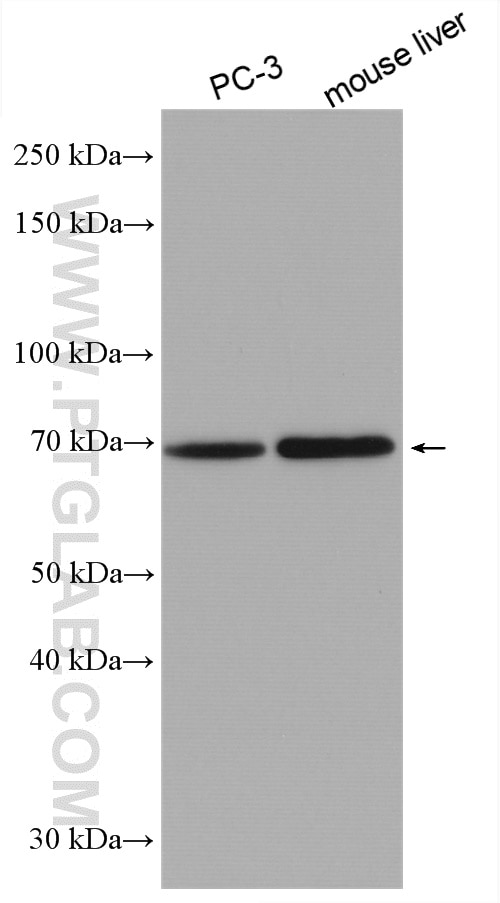- Featured Product
- KD/KO Validated
HAS3 Polyklonaler Antikörper
HAS3 Polyklonal Antikörper für IHC, WB,ELISA
Wirt / Isotyp
Kaninchen / IgG
Getestete Reaktivität
human, Maus, Ratte
Anwendung
WB, IHC, FC, ELISA
Konjugation
Unkonjugiert
Kat-Nr. : 15609-1-AP
Synonyme
Galerie der Validierungsdaten
Geprüfte Anwendungen
| Erfolgreiche Detektion in WB | PC-3-Zellen, L02-Zellen, Mauslebergewebe |
| Erfolgreiche Detektion in IHC | humanes Leberkarzinomgewebe Hinweis: Antigendemaskierung mit TE-Puffer pH 9,0 empfohlen. (*) Wahlweise kann die Antigendemaskierung auch mit Citratpuffer pH 6,0 erfolgen. |
Empfohlene Verdünnung
| Anwendung | Verdünnung |
|---|---|
| Western Blot (WB) | WB : 1:500-1:1000 |
| Immunhistochemie (IHC) | IHC : 1:100-1:400 |
| It is recommended that this reagent should be titrated in each testing system to obtain optimal results. | |
| Sample-dependent, check data in validation data gallery | |
Veröffentlichte Anwendungen
| KD/KO | See 1 publications below |
| WB | See 5 publications below |
| IHC | See 2 publications below |
| FC | See 1 publications below |
Produktinformation
15609-1-AP bindet in WB, IHC, FC, ELISA HAS3 und zeigt Reaktivität mit human, Maus, Ratten
| Getestete Reaktivität | human, Maus, Ratte |
| In Publikationen genannte Reaktivität | human |
| Wirt / Isotyp | Kaninchen / IgG |
| Klonalität | Polyklonal |
| Typ | Antikörper |
| Immunogen | HAS3 fusion protein Ag7999 |
| Vollständiger Name | hyaluronan synthase 3 |
| Berechnetes Molekulargewicht | 63 kDa |
| Beobachtetes Molekulargewicht | 63 kDa |
| GenBank-Zugangsnummer | BC021853 |
| Gene symbol | HAS3 |
| Gene ID (NCBI) | 3038 |
| Konjugation | Unkonjugiert |
| Form | Liquid |
| Reinigungsmethode | Antigen-Affinitätsreinigung |
| Lagerungspuffer | PBS mit 0.02% Natriumazid und 50% Glycerin pH 7.3. |
| Lagerungsbedingungen | Bei -20°C lagern. Nach dem Versand ein Jahr lang stabil Aliquotieren ist bei -20oC Lagerung nicht notwendig. 20ul Größen enthalten 0,1% BSA. |
Hintergrundinformationen
HAS3(hyaluronan synthase 3) belongs to the NodC/HAS family, which are widely expressed in human tissues and appear to function in embryogenesis, wound healing and other processes associated with cellular proliferation and migration(PMID:14566823). HAS3 is involved in the synthesis of the unbranched glycosaminoglycan hyaluronan, or hyaluronic acid, which is a major constituent of the extracellular matrix. It may play a role in the progression of colon cancer and, as such, may provide novel targets for diagnostic and therapeutic interventions(PMID:14566823). It has 2 isoforms produced by alternative splicing and the protein has a glycosylation site.
Protokolle
| Produktspezifische Protokolle | |
|---|---|
| WB protocol for HAS3 antibody 15609-1-AP | Protokoll herunterladen |
| IHC protocol for HAS3 antibody 15609-1-AP | Protokoll herunterladen |
| Standard-Protokolle | |
|---|---|
| Klicken Sie hier, um unsere Standardprotokolle anzuzeigen |
Publikationen
| Species | Application | Title |
|---|---|---|
Int J Mol Sci Elevation of Hyaluronan Synthase by Magnesium Supplementation Mediated through the Activation of GSK3 and CREB in Human Keratinocyte-Derived HaCaT Cells. | ||
Cancers (Basel) C1q-HA Matrix Regulates the Local Synthesis of Hyaluronan in Malignant Pleural Mesothelioma by Modulating HAS3 Expression. | ||
Mol Med Rep miR‑29a‑3p represses proliferation and metastasis of gastric cancer cells via attenuating HAS3 levels.
| ||
Dis Model Mech Adenosine and hyaluronan modulate lung fibrosis and pulmonary hypertension in combined pulmonary fibrosis and emphysema (CPFE). |






